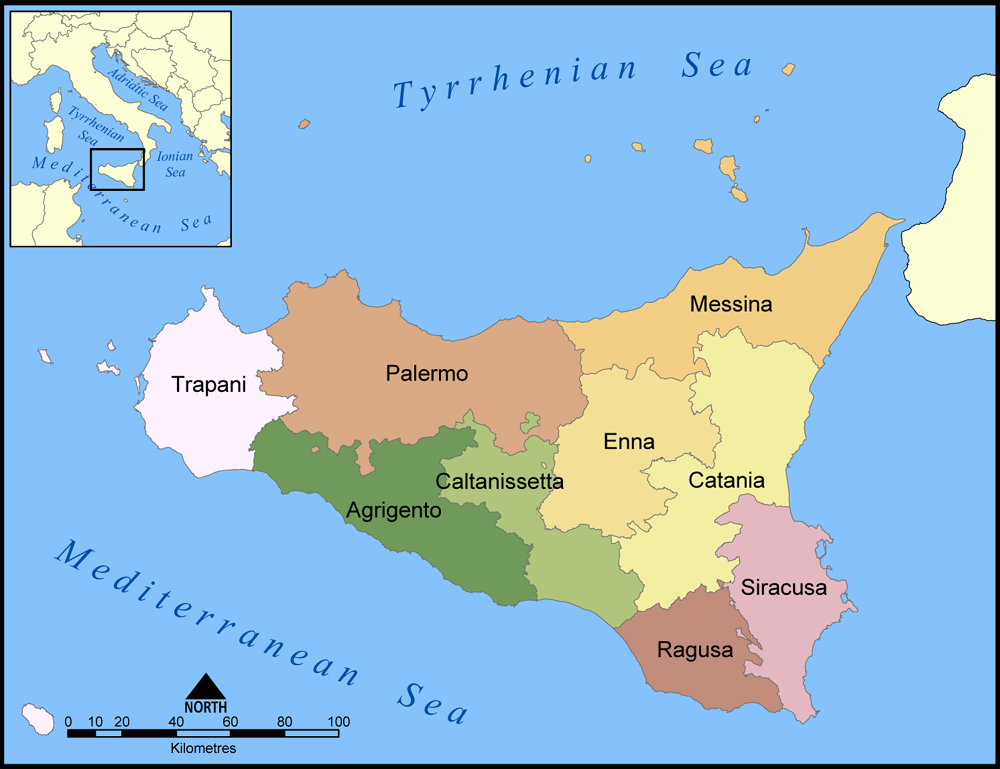Palermo

History
The regional capital of Sicily has naturally been the target for all of the many cultures that have had a hand in Sicily over the centuries. Founded sometime between the 8th and 6th centuries BC, Palermo was first settled by the Phoenicians. The Romans had control of Palermo beginning in 254 BC, where the city remained and prospered until the Byzantine empire took over for about 300 years. Palermo experienced cultural and economic prosperity under the Arabic rulers who began their reign in 831. While the rest of Europe was under the blanket of the Middle Ages, Palermo was flourishing with wonderful architecture, art. gardens and culture. The Normans, from France, wrested control of Palermo from the Arabs after about 200 years, and proceeded to build some of the greatest monuments the city has seen, including the Cathedral in Monreale and the Palatine Chapel. Prosperity continued under the rule of the Swabians and the famous king Federico II, but suffered a setback under the French rule, which resulted in the War of the Sicilian Vespers, which began in 1282 and lasted 20 years. The main objective of the war was to remove the French from Sicily and it worked. Three hundred years of Spanish rule, from 1400 to 1700, returned Palermo to its prosperous and prgoressive time; control of Palermo switched hands a few more times, from the Spanish to the Sabuado family, then the Austrians, the Spanish again and then the French reasserted themselves under the Bourbon kings. The entire island revolted at least twice; this was quite a tumultuous time for people in Palermo. Finally, Garibaldi ran the French out of Palermo, and Palermo annexed itself to the Kingdom of Italy in 1870.
Cuisine
Because Palermo was always an important city, its cuisine was more influenced by the parade of cultures that had dominion over Sicily through the ages. The egos of the Monsus (equivalent of a master chef) had a hand in this, as each monsu was determined that foreign visitors and dignitaries be impressed with the culinary delights of Sicily. As with modern cities, food trends in the city then spread through the rest of the province, making Palermo cuisine quite progressive.
Elaborate dishes such as Arancine (stuffed fried rice balls) and Caponata (stew of eggplant and other vegetables) were created in Palermo. Palermo chefs also loved their sweets: cannoli, cassata and many other desserts, flavored with chocolate, cinnamon, rose water, watermelon, pistachios and more, had their origins in and around the city of Palermo. The gelo di mellone, a watermelon gelatine dessert, is not typically found outside the province, although some of the other dishes have migrated across Sicily and, indeed, much of the world. Of course, Sicilians in general love ice cream, or gelato, and in the province of Palermo, ice cream is made with just about everything imaginable and is eaten year-round. Frozen flavored ices are popular as well, with lemon, coffee and almond being some the most popular flavors.
In outlying areas of the province, seafood is very important, including exotic delicacies such as sea urchins and boiled, chopped octopus.
Tourism
When visting Palermo, the Cathedral of Monreale, located in the town of Monreale, is not to be missed. This magnificent building can take an entire day to explore. The Palatine Chapel, featuring Byzantine, Arabic and Siculo-Roman architecture, is another extraordinary buidling; both of these contain exquisite mosaic and fresco works. There are plenty of other chapels and cathedrals in and around the city of Palermo, enough to get delightfully lost in. There are also two wonderful theatrical monuments in the city of Palermo: the Teatro Massimo, an opera house, and the Teatro Politeama, which was built between 1867 and 1874. Not for the squeamish, the Capuchin Catacombs, built in 1621, displays the remarkably well-preserved mummified remains of the wealthy people of Palermo who passed on between 1621 and 1881. Other wonderful museums include the Sicilian Regional Gallery, full of art and sculpture, and the Archaelogical Museum, both located in the city of Palermo.
There are also delightful resorts along the coast, including Mondello which lies along a beautiful sheltered bay. Take a tour of the coast from Porticello to Capo Zafferano (Saffron Cape) for a lok at beautiful shoreline and quaint fishing villages. The town of Cefalu also offers a wonderful mix of beautiful water, glorious architecture and a community that loves tourists!
Palermo Province Information
Palermo Tourism Site
Cathedral of Monreale
Cefalu
City of Palermo Tourism Website
Sicilian Provinces: Agrigento, Caltanissetta, Catania, Enna, Messina, Palermo, Ragusa, Siracusa, Trapani
Agrigento
Caltanissetta
Catania
Enna
Messina
Palermo
Ragusa
Siracusa
Trapani